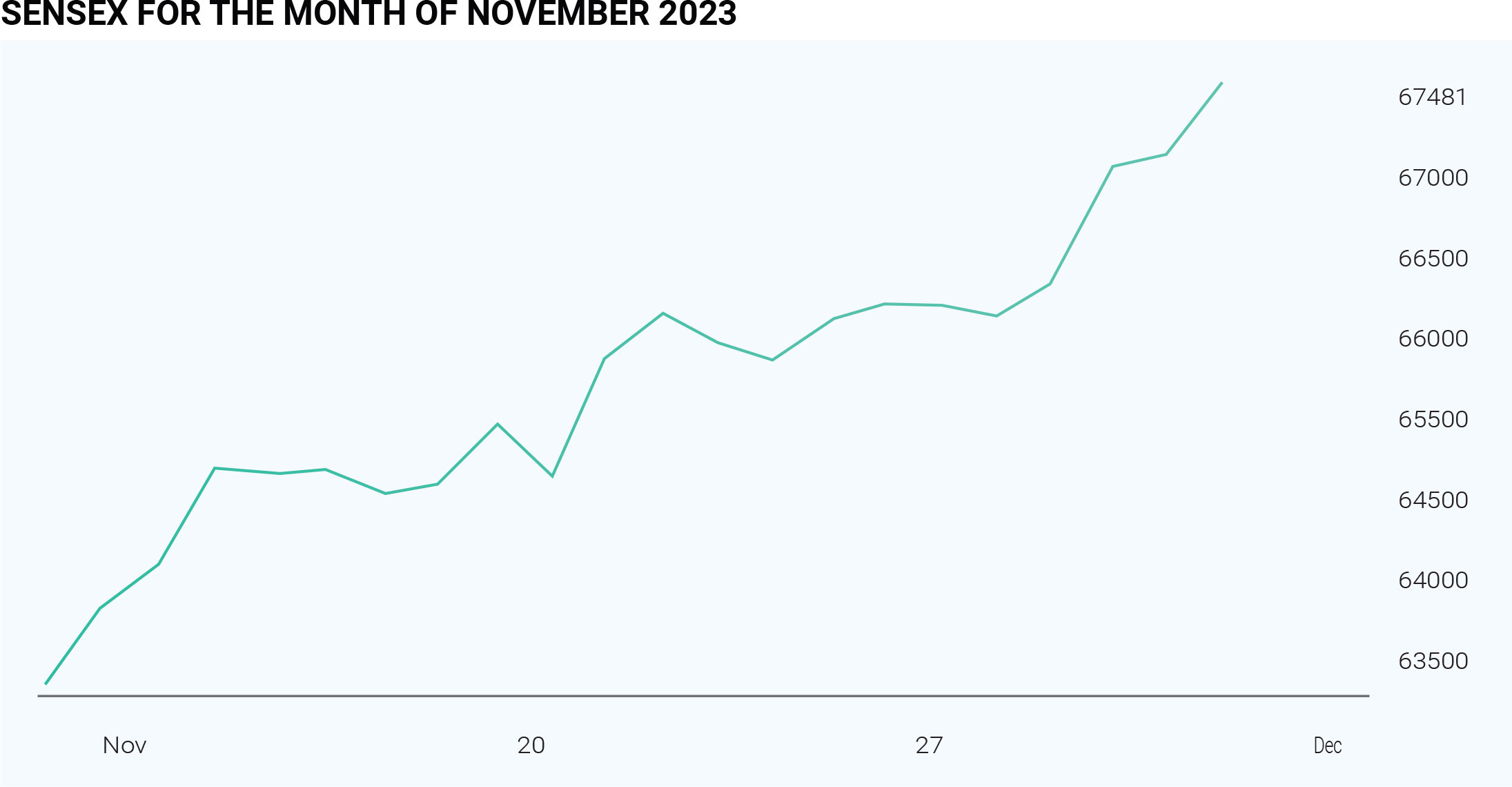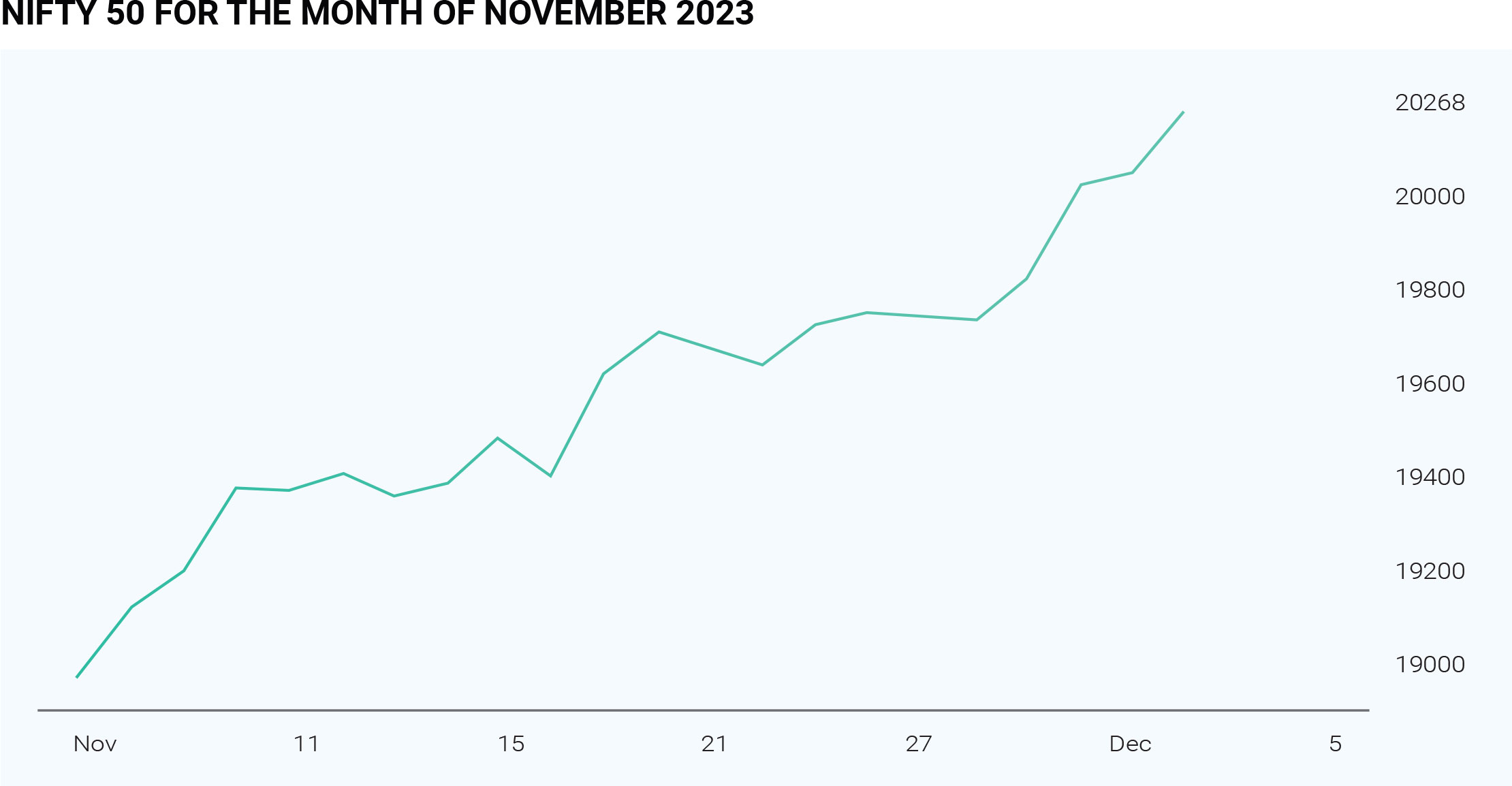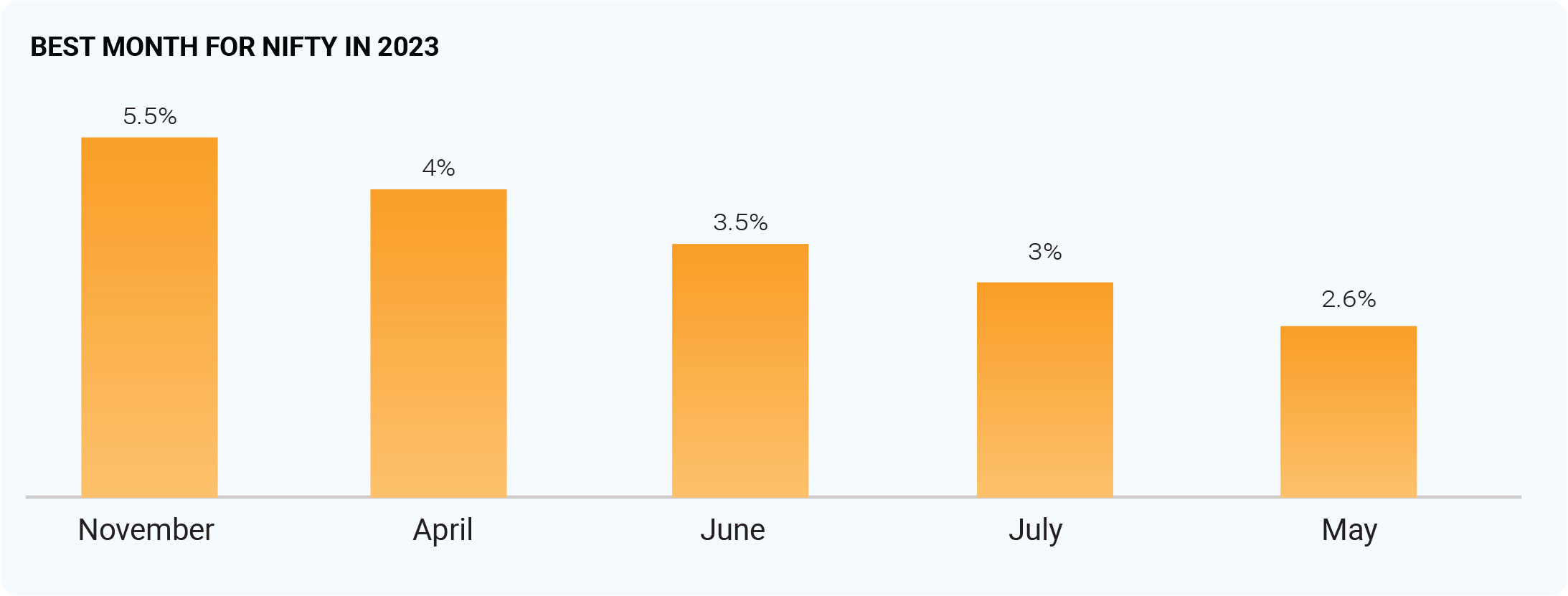The month of November 2023 brings back the lustre
which was lost during the last 2-3 months. The festive
month started with a dreary note, but then the Nifty 50
paced up touching all-time highs. Indian stock markets
stood 4th around the world touching $4 trillion of market
capitalisation. The market valuation of BSE-listed
companies crossed a record $4 trillion for the first time
on November 29, on the back of positive market
sentiment in Indian equities. The market capitalisation of
BSE-listed companies reached ₹333 lakh crore, or $4
trillion at the exchange rate of 83.31. It has climbed over
$600 billion since the beginning of the year. BSE-listed
firms hit the $1-trillion market cap milestone in May 2007
and it took over 10 years to double. The market cap
surpassed $2 trillion in July 2017. BSE m-cap had hit the
$3 trillion mark in May 2021. Small-cap and mid-cap
categories have outperformed amid the global easing
policy actions. This was triggered post US banking crisis
and strong margin outperformance driven by input cost
moderation.


The major factors contributing to this upsurge were
robust economic numbers, favourable exit polls, and the
return of Foreign Portfolio Investors (FPIs) to the Indian
markets. The Indian economy grew by 7.6% during
Q2FY24, maintaining its position as the fastest-growing
major economy globally. India's Q2 GDP growth
surpassed both market estimates and projections by the
Reserve Bank of India. Recently, CLSA stated that it
anticipates India's soaring GDP growth will propel it to
the top three of the world’s largest economies, increasing
from $3.4 trillion today to surpass Japan’s by 2027,
reaching $29 trillion by 2047, and further expanding to
$45 trillion by 2052. By then, only China and the US will
have larger economies, with the possibility of India
overtaking the US economy in size by 2052 if significant
reforms unleash efficiencies.
The exit polls for the five state elections indicate political
stability ahead of the General Elections in 2024. A
decisive win for the BJP would strengthen the consensus
view that the party is well-positioned for the 2024 general
elections. This outcome is likely to further boost market
confidence, as policy continuity is viewed positively for
medium-term growth. The market favours political
stability and a reform-oriented, market-friendly
government."

After a two-month hiatus, Foreign Institutional Investors
(FIIs) made a comeback as net buyers of Indian equities,
injecting a total of ₹13,474 crore over only six sessions.
In November, Foreign Portfolio Investors (FPIs) ended a
two-month selling streak, recording a net inflow of
₹9,001 crore. This marked a significant shift from the
over ₹39,000 crore worth of shares sold in September
and October. Foreign portfolio investors displayed a
distinct preference for larger sectors, particularly
financials, FMCG, and oil and gas. Moreover, FPIs in the
domestic debt market reached a six-year high in
November, driven by robust yields and the inclusion of
domestic bonds in JPMorgan's Emerging Market Global
Bond Index. Data from the National Securities Depository
Ltd. reveals that foreign portfolio investors infused Rs
14,556 crore as of November 29. The decline in US
treasury yields and the softening of the dollar, coupled
with rising speculation that the US Federal Reserve has
concluded its key interest rate hikes, have triggered
foreign fund inflows into emerging markets, including
India.
Last month, global pressures took a favourable turn. Oil
prices sharply dropped to $80/bbl due to a slowdown in
the growth of China and European nations. Additionally,
the expected soon-to-be Venezuelan crude supply added
to the decline. The decrease in crude oil prices is
anticipated to help India improve its current deficit
projections. Lower-than-expected inflation readings led
to a significant correction in US bond yields. From close
to 5%, 10-year yields dropped to approximately 4.5%. This
subtle change also attracted Foreign Portfolio Investors
(FPIs) inflows. The US market rallied almost 10% in the
month of November. US 10-year bond yields and the
dollar index were cooling off, providing strength to the
market. This decline in yields gained momentum amid
growing speculation that the U.S. Federal Reserve might
initiate interest rate cuts next year. FOMC minutes stated
that in the upcoming months, data would help clarify the
extent to which the disinflation process was continuing,
aggregate demand was moderating in the face of tighter
financial and credit conditions, and labour markets were
reaching a better balance between demand and supply.
As markets reach new highs, the prevailing risk cannot
be ignored. Amid expectations that the central bank will
maintain the benchmark interest rates, the rate-setting
monetary policy panel, led by RBI Governor Shaktikanta
Das and consisting of six members, will commence
deliberations in the upcoming week. The three-day
meeting is scheduled from December 6 to December 8,
with the decision to be announced on Friday. The RBI has
held the repo rate steady at 6.5% since February of this
year. This marks the central bank's fourth MPC meeting
for fiscal 2023-24 and the final one for the calendar year
2023. The market anticipates the central bank to retain
its current stance, given that India's retail inflation
persists above its 4% target. The US Fed chairman
mentioned that inflation is steadily slowing, but it is
premature to declare victory or discuss potential interest
rate cuts. Powell reiterated the central bank's
commitment to a cautious approach on interest rates,
noting that the hoped-for 'soft landing' of the US
economy appears to be materializing. Meanwhile, global
markets, including the European Central Bank, are
experiencing bullish trends. The European Central Bank
concluded its rate-hiking cycle in response to easing
inflation.
As markets move at lightning speed, regulators are
closely monitoring derivatives traders and major sectors,
particularly banks. SEBI has issued repeated warnings to
retail investors, emphasizing the need for caution in
derivatives trading. In the Indian market, the banking
sector, a favourite among investors, has seen impressive
gains. However, the RBI is actively working to address
defaulters and implement changes in rules and
regulations.
As we approach December, several significant
challenges loom on the horizon, including the FED rate
decision, MPC meeting, global festivals, unpredictable
geopolitical tensions, and global inflation. All these
factors could potentially impact market movements in
the future. Despite these challenges, there is hope that
the year will end on a positive note for the Indian stock
markets.

